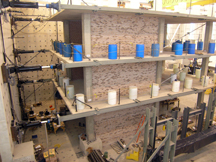Feb 12 2009
Civil engineers using a specialized laboratory at Purdue University have demonstrated the effectiveness of a simple, inexpensive method to strengthen buildings that have a flaw making them dangerously vulnerable to earthquakes.
 Researchers built an entire three-story building inside Purdue's Robert L. and Terry L. Bowen Laboratory for Large-Scale Civil Engineering Research to test the effectiveness of a simple, inexpensive method to strengthen buildings and reduce their vulnerability to earthquakes
Researchers built an entire three-story building inside Purdue's Robert L. and Terry L. Bowen Laboratory for Large-Scale Civil Engineering Research to test the effectiveness of a simple, inexpensive method to strengthen buildings and reduce their vulnerability to earthquakes
The flaw is widespread in China, Latin America, Turkey and other countries. The buildings have too many "partial-height" walls between structural columns and could be easily strengthened by replacing some windows with ordinary masonry bricks, said Santiago Pujol, an assistant professor of civil engineering at Purdue.
Partial-height walls do not extend all the way to the ceiling, sometimes causing structural columns to fail during powerful quakes. The strengthening would not only be low-cost but also easy to install, Pujol said.
"There are countries where there is a huge gap between the building codes and what is actually being built," he said. "Sure, government enforcement is lax, but I would like to think that if we engineers made the standards easier to apply they would also be easier to enforce. That's where we have an obligation to find solutions that are simple, affordable and effective."
The researchers built an entire three-story building inside Purdue's Robert L. and Terry L. Bowen Laboratory for Large-Scale Civil Engineering Research in work led by former Purdue civil engineering doctoral student Damon Fick, who is now an assistant professor in civil and environmental engineering at the South Dakota School of Mines and Technology.
The reinforced-concrete structure was subjected to forces simulating the effects of a strong earthquake by pulling and pushing the building with six powerful hydraulic "actuators." The six actuators could be likened to giant car jacks that exerted a total of about 300,000 pounds of force on the structure.
Findings were detailed in a paper presented in October during the 14th World Conference on Earthquake Engineering in Beijing, China. The paper was written by Pujol, civil engineer Amadeo Benavent-Climent from the Department of Structural Mechanics at the University of Granada, civil engineer Mario E. Rodriguez from the Instituto de Ingenieria in Mexico City, and civil engineer J. Paul Smith-Pardo from Berger/Abam Engineers Inc. in Federal Way, Wash.
"The most important result is that we showed that buildings with partial-height walls, which are very common throughout the world, especially in schools, can be improved very easily with not a lot of investment by simply rearranging the masonry walls," Pujol said. "Granted, this is not the best technology can offer, but this is cheap, and people can do it with their own hands."
Findings indicated the strengthened building was twice as strong and six times stiffer than the same structure having only reinforced-concrete columns but no walls. The building's roof displacement, or how much it moved at roof-level, was 1.5 percent of its total height, which is within what could be expected for a building of similar characteristics during a moderately strong earthquake, Pujol said.
The researchers also used computational simulations to show that the reinforced structure would likely have withstood the ground motion caused by strong earthquakes recorded in the past.
The engineers studied buildings damaged by earthquakes in Turkey in 1999 and 2000 and another earthquake in Peru in 2007. In the Peru quake, columns located between windows were destroyed in one building, whereas another building in the immediate vicinity was not seriously damaged.
"So I was very much intrigued," Pujol said. "Why were the columns in one building destroyed while a very similar building in the same area looked fine?"
Thirteen out of 20 columns were destroyed in the damaged building, and no columns failed in the other.
Pujol discovered that the building without serious damage had more full-height walls completely filling the spaces between columns than the other building.
He theorized that filling in some of the partial-height walls with masonry bricks might make vulnerable structures sturdy enough to prevent collapse during strong earthquakes and decided to test this hypothesis at the Purdue laboratory.
Fick took on the challenge of precisely controlling all six of the actuators during testing, which was critical to ensuring the researchers' safety as the building was pushed and pulled, Pujol said.
Features in the Bowen Laboratory, completed in 2004, include a testing area with a "strong floor" and 40-foot-high "reaction wall" containing numerous holes in which to anchor the hydraulic actuators that apply forces to large-scale structural models.
This work was partially funded by the U.S. Army and the National Science Foundation.